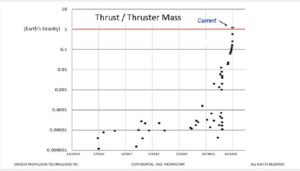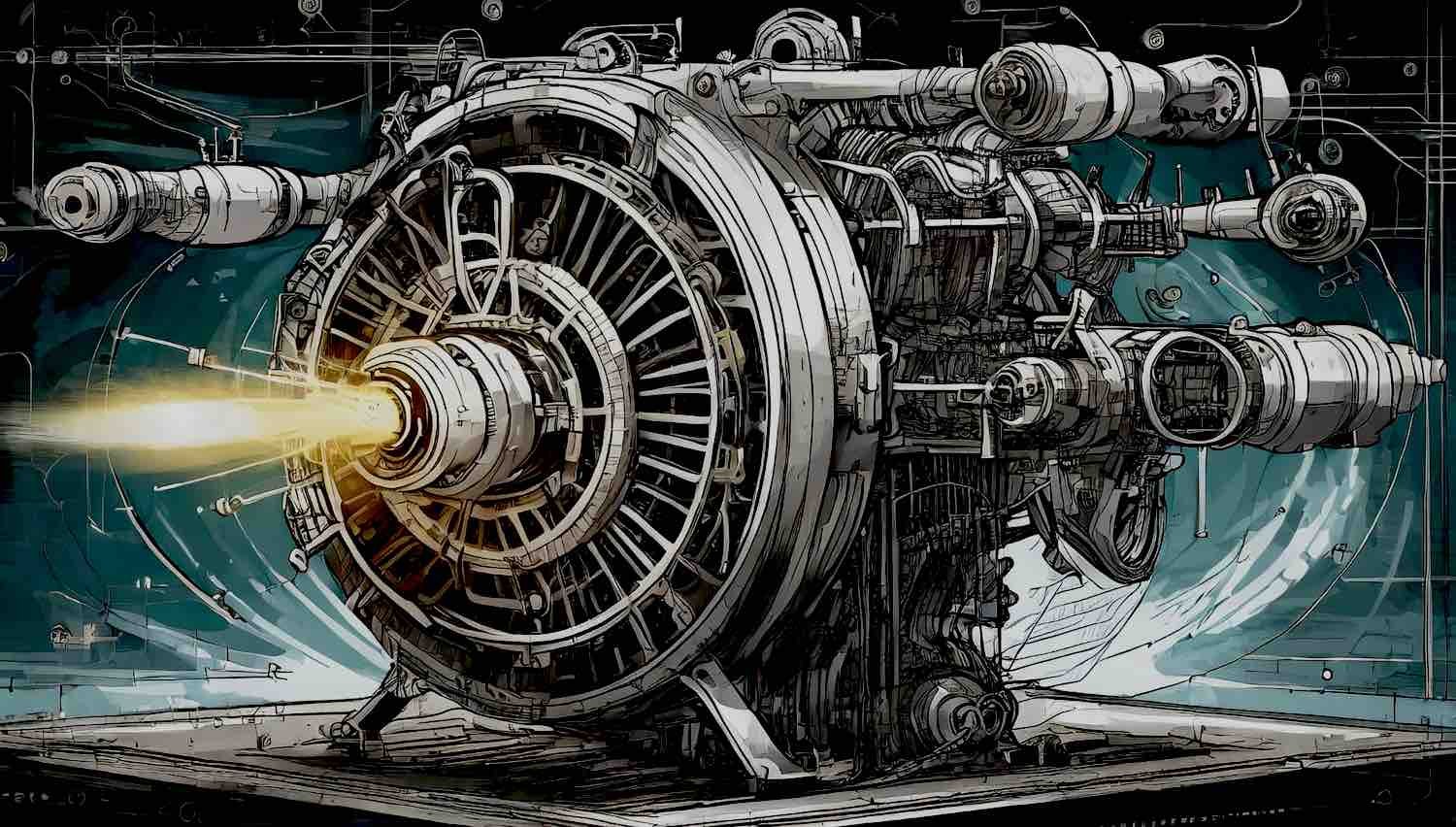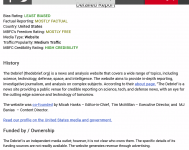jward
passin' thru
thedebrief.org
Dr. Charles Buhler, a NASA engineer and the co-founder of Exodus Propulsion Technologies, has revealed that his company’s propellantless propulsion drive, which appears to defy the known laws of physics, has produced enough thrust to counteract Earth’s gravity.
A veteran of such storied programs as NASA’s Space Shuttle, the International Space Station (ISS), The Hubble Telescope, and the current NASA Dust Program, Buhler and his colleagues believe their discovery of a fundamental new force represents a historic breakthrough that will impact space travel for the next millennium.
“The most important message to convey to the public is that a major discovery occurred,” Buhler told The Debrief. “This discovery of a New Force is fundamental in that electric fields alone can generate a sustainable force onto an object and allow center-of-mass translation of said object without expelling mass.”
“There are rules that include conservation of energy, but if done correctly, one can generate forces unlike anything humankind has done before,” Buhler added. “It will be this force that we will use to propel objects for the next 1,000 years… until the next thing comes.”
Cover image of Dr. Buhler’s APEC Presentation. Image Credit: Exodus Propulsion Technologies, Buhler et al.
In conjunction with that presentation, “The Discovery of Propellantless Propulsion: The Direct Conversion of Electrical Energy into Physical Thrust,” Dr. Buhler also sat down with APEC co-founder and moderator Tim Ventura to explain how his past in electrostatics, which is his primary area of expertise, ended up being a key component of his discovery of this new force.
“You are NASA’s subject matter expert in electrostatics,” Ventura clarified in the first part of the interview. “So, if anyone would know about conventional explanations for anomalous measurements (for the measured thrust), it would be you, right?”
“That’s true,” Buhler conceded with an outwardly humble shrug.
A quick look at Dr. Buhler’s background confirms that he is indeed one of NASA’s top experts in electrostatics. In addition to overseeing the management of electrostatic discharge (ESD) and ESD safety for the Space Shuttle, the ISS, and Hubble, Dr. Buhler also established NASA’s Electrostatics and Surface Physics Laboratory at Kennedy Space Center.
His Exodus Propulsion Technologies team is equally impressive. According to a slide from his APEC presentation, “the Team consists of a mix of engineers and scientists from NASA, Blue Origin, Air Force, ExxonMobil as well as successful legal and businessmen.”
Somewhat surprisingly, Buhler says that when he and his colleagues first began looking into propellantless propulsion ideas over two decades ago, they did not expect electrostatics to be the answer. Instead, he and his team explored other avenues for as many as 25 years before landing on electrostatics as the key to unlocking the door of this new force.
“Nature has its own way of doing things,” Buhler explained, “and it is our job to uncover what nature does. It just happened to fall into my lap in what I’m the expert in.”
For example, from 2016 to the end of 2020, their best devices were producing a little more than one hundred thousandth of a gravity. In the coming years, that would go up exponentially. For clarification, Buhler told The Debrief that measuring thrust in terms of a percentage of gravity reflects the force generated divided by the test article.
“The aim is to approach and exceed unity,” he explained, “which means the article would generate enough thrust to lift itself in Earth’s gravity, and that’s defined as 1 gravity of thrust.”
Buhler says they commonly measured the forces in milliNewtons, but they prefer to describe the thrust in terms of gravity since that is the ultimate goal of propulsion physics.
“The highest we have generated on a stacked system is about 10 mN,” Buhler told The Debrief. “The magnitude is not important, really, since anything above zero would work in space!”
In the years and months leading up to the breakthrough thrust measurement, Buhler and his team took great care to methodically eliminate anything else that could account for the tiny yet measurable force they were seeing. This detailed and painstaking work resulted in the team’s overriding patent, which was granted in 2020.
With fresh momentum, Buhler says they also began construction of a custom-made vacuum chamber that would allow them to simulate the environment of deep space. If something else was causing the force, this chamber was built to identify it.
According to the APEC presentation, that chamber was completed at the end of 2020. Between January and September 2021, 146 separate articles were tested, each seemingly confirming the presence of measurable thrust. The team also tested different configurations that eliminated the old designs using asymmetrical capacitors and instead employed models with opposing asymmetrical plates.
This slide from Dr. Buhler’s APEC presentation shows the custom-made vacuum chamber built to test their propellantless Propulsion drive in a simulated space environment. Image Credit: Exodus Propulsion Technologies, Buhler, et al.
“Our materials are composed of many types of charge carrier coatings that have to be supported on a dielectric film,” Buhler told The Debrief. “Our aim is to make it as lightweight as possible, but that is sometimes difficult since the films and their coatings have to have a high dielectric breakdown strength.”
After employing these new designs, the next series of tests produced even more encouraging results. The team once again confirmed the thrust, but the new approach resulted in an order of magnitude jump to one ten-thousandth of a gravity. This was still not enough to leave the planet, but it was enough to know they were on the right track.
Then, in 2022, something astounding happened. According to Buhler, his team began to see significant jumps in the force being generated.
A quick look at a chart he presented to APEC shows that tests performed between early 2022 and November 2023 resulted in a rapid climb, moving from one thousandth, one hundredth, and even one-tenth of gravity all the way up to one full Earth gravity. This means that their current devices, which Buhler told The Debrief “weigh somewhere between 30-40 grams on their own” without the attached test equipment, were producing enough thrust to counteract the full force of one Earth gravity.
 A slide from Dr. Buhler’s APEC presentation highlights just a few of the hundreds of tests his team ran on their propellantless propulsion drive between 2016 and 2023. Image Credit: Exodus Propulsion Technologies, Buhler, et al.
A slide from Dr. Buhler’s APEC presentation highlights just a few of the hundreds of tests his team ran on their propellantless propulsion drive between 2016 and 2023. Image Credit: Exodus Propulsion Technologies, Buhler, et al.
After decades of research, Buhler says he and his team had shown unequivocally that a new, fundamental force was at work and that his devices were tapping into that force to produce thrust without emitting any mass or propellant.
“Essentially, what we’ve discovered is that systems that contain an asymmetry in either electrostatic pressure or some kind of electrostatic divergent field can give a system of a center of mass a non-zero force component,” Buhler explained. “So, what that basically means is that there’s some underlying physics that can essentially place force on an object should those two constraints be met.”
Although the former has had its thrust confirmed by NASA Warp Drive specialist Harold G. “Sonny” White’s EagleWorks Lab and a second test in China, both of which still remain controversial, neither has yet to be tested in space. The Quantum Drive came close after a launch last November, but a failure in the satellite’s electrical systems unrelated to the drive scuttled that test before it could confirm the drive’s thrust.
When asked by The Debrief about competing companies working on similar propulsion concepts, Buhler said he believes his work could actually explain the effects some of these other concepts are seeing. However, he did concede that there is some concern that some of the more recent devices could violate his team’s patent.
A slide from Dr. Buhler’s APEC presentation highlights some of the other propelantless propulsion concepts and scientific mysteries that may be explained by his team’s findings. Image Credit: Exodus Propulsion Technologies, Buhler, et al.
“The thing that we worry about are the companies that have appeared out of nowhere after the patent came out and had instant success without the years of rigor and no acknowledgment of our patent,” he said.
Still, Buhler believes companies interested in this type of potential propulsion breakthrough should contact Exodus so he and his team can share their experience and expertise.
“Knowledge of gas breakdown, corona generation, brush discharges, streamers, glow discharges, plasma physics, etc., is usually too much for engineers to bear alone,” he told The Debrief, “and the number of experts in Electrostatics is very, very few.
“We hope companies will want to license our technology, which is mutually beneficial,” he added. “We can help their technology and gain some funding for our time to do so.”
If there are companies interested in working with Exodus Propulsion Technologies, Buhler asks that they contact him and his team via their LinkedIn page.
“We can see some of these things sit on a scale for days, and if they still have charge in them, they are still producing thrust,” he told Ventura. “It’s very hard to reconcile, from a scientific point of view because it does seem to violate a lot of energy laws that we have.”
Up next, Buhler says his team is seeking funding to test their devices in space to better understand the force at work.
“We’re hoping to do some demos,” said Buhler. “Some space demos. That’s what we’re trying to get some funding to do. I think that would be a great way to show off the technology.”
Besides proving once and for all that the force they are seeing is real, the accomplished engineer believes that such tests could encourage other scientists to search for an explanation of what exactly it is they are seeing.
“I think it’s a good opportunity for people to run these tests, look at them, watch them go in space, watch it move in space, and then say, ‘what does it imply? What are the implications?’”
Until that time, Buhler says he believes his work proves that the force they are seeing is “fundamental” and that understanding it is the next logical step.
“You can’t deny this,” he told Ventura. “There’s not a lot to this. You’re just charging up Teflon, copper tape, and foam, and you have this thrust.”
So, while his team believes their experiments speak for themselves, the veteran scientist says he also believes it is the job of science to analyze and understand this discovery. If successful, he thinks it may even address some of the harder questions in science, including the nature of dark energy or even space/time itself.
“It’s easy to make these things,” he said, “so it’s a tool for the scientific community to use to try to explore those hard questions.”
As far as his own thoughts about the nature of the force his team has uncovered, the refreshingly honest NASA veteran demurred, saying only that he believes scientists besides himself are in the perfect position to test and study their results and to come up with the answers.
“It’s going to take a physicist much smarter than me to come up with all of that,” Dr. Buhler quipped.
“But the QED is there.”

 thedebrief.org
thedebrief.org
NASA Veteran’s Propellantless Propulsion Drive That Physics Says Shouldn’t Work Just Produced Enough Thrust to Overcome Earth’s Gravity - The Debrief
Dr. Charles Buhler, a NASA engineer and the co-founder of Exodus Propulsion Technologies, has revealed that his company’s propellantless propulsion drive, which appears to defy the known laws of physics, has produced enough thrust to counteract Earth’s gravity.
A veteran of such storied programs as NASA’s Space Shuttle, the International Space Station (ISS), The Hubble Telescope, and the current NASA Dust Program, Buhler and his colleagues believe their discovery of a fundamental new force represents a historic breakthrough that will impact space travel for the next millennium.
“The most important message to convey to the public is that a major discovery occurred,” Buhler told The Debrief. “This discovery of a New Force is fundamental in that electric fields alone can generate a sustainable force onto an object and allow center-of-mass translation of said object without expelling mass.”
“There are rules that include conservation of energy, but if done correctly, one can generate forces unlike anything humankind has done before,” Buhler added. “It will be this force that we will use to propel objects for the next 1,000 years… until the next thing comes.”
The Serendipity of Discovering the propellantless Propulsion Drive
To document his team’s discovery as well as the process behind their work, which Dr. Buhler cautions is in no way affiliated with NASA or the U.S. Government, the outwardly amiable researcher presented his findings at a recent Alternative Propulsion Energy Conference (APEC). Filled with both highly-credentialed career engineers and propulsion hobbyists, APEC is an organization The Debrief once referred to as the World’s Most Exclusive (And Strange) Anti-Gravity Club.Cover image of Dr. Buhler’s APEC Presentation. Image Credit: Exodus Propulsion Technologies, Buhler et al.
In conjunction with that presentation, “The Discovery of Propellantless Propulsion: The Direct Conversion of Electrical Energy into Physical Thrust,” Dr. Buhler also sat down with APEC co-founder and moderator Tim Ventura to explain how his past in electrostatics, which is his primary area of expertise, ended up being a key component of his discovery of this new force.
“You are NASA’s subject matter expert in electrostatics,” Ventura clarified in the first part of the interview. “So, if anyone would know about conventional explanations for anomalous measurements (for the measured thrust), it would be you, right?”
“That’s true,” Buhler conceded with an outwardly humble shrug.
A quick look at Dr. Buhler’s background confirms that he is indeed one of NASA’s top experts in electrostatics. In addition to overseeing the management of electrostatic discharge (ESD) and ESD safety for the Space Shuttle, the ISS, and Hubble, Dr. Buhler also established NASA’s Electrostatics and Surface Physics Laboratory at Kennedy Space Center.
His Exodus Propulsion Technologies team is equally impressive. According to a slide from his APEC presentation, “the Team consists of a mix of engineers and scientists from NASA, Blue Origin, Air Force, ExxonMobil as well as successful legal and businessmen.”
Somewhat surprisingly, Buhler says that when he and his colleagues first began looking into propellantless propulsion ideas over two decades ago, they did not expect electrostatics to be the answer. Instead, he and his team explored other avenues for as many as 25 years before landing on electrostatics as the key to unlocking the door of this new force.
“Nature has its own way of doing things,” Buhler explained, “and it is our job to uncover what nature does. It just happened to fall into my lap in what I’m the expert in.”
The Device and The Thrust
Throughout his APEC presentation, Buhler highlights his team’s long chain of experiments, with a more detailed focus on the last decade. That in-depth account, which includes a lot of the mathematics behind what they discovered, not only shows how he and his team developed different models and configurations of their propellantless propulsion drive but also the significant breakthroughs many of these steps uncovered.For example, from 2016 to the end of 2020, their best devices were producing a little more than one hundred thousandth of a gravity. In the coming years, that would go up exponentially. For clarification, Buhler told The Debrief that measuring thrust in terms of a percentage of gravity reflects the force generated divided by the test article.
“The aim is to approach and exceed unity,” he explained, “which means the article would generate enough thrust to lift itself in Earth’s gravity, and that’s defined as 1 gravity of thrust.”
Buhler says they commonly measured the forces in milliNewtons, but they prefer to describe the thrust in terms of gravity since that is the ultimate goal of propulsion physics.
“The highest we have generated on a stacked system is about 10 mN,” Buhler told The Debrief. “The magnitude is not important, really, since anything above zero would work in space!”
In the years and months leading up to the breakthrough thrust measurement, Buhler and his team took great care to methodically eliminate anything else that could account for the tiny yet measurable force they were seeing. This detailed and painstaking work resulted in the team’s overriding patent, which was granted in 2020.
With fresh momentum, Buhler says they also began construction of a custom-made vacuum chamber that would allow them to simulate the environment of deep space. If something else was causing the force, this chamber was built to identify it.
According to the APEC presentation, that chamber was completed at the end of 2020. Between January and September 2021, 146 separate articles were tested, each seemingly confirming the presence of measurable thrust. The team also tested different configurations that eliminated the old designs using asymmetrical capacitors and instead employed models with opposing asymmetrical plates.
This slide from Dr. Buhler’s APEC presentation shows the custom-made vacuum chamber built to test their propellantless Propulsion drive in a simulated space environment. Image Credit: Exodus Propulsion Technologies, Buhler, et al.
“Our materials are composed of many types of charge carrier coatings that have to be supported on a dielectric film,” Buhler told The Debrief. “Our aim is to make it as lightweight as possible, but that is sometimes difficult since the films and their coatings have to have a high dielectric breakdown strength.”
After employing these new designs, the next series of tests produced even more encouraging results. The team once again confirmed the thrust, but the new approach resulted in an order of magnitude jump to one ten-thousandth of a gravity. This was still not enough to leave the planet, but it was enough to know they were on the right track.
Breakthrough in 2023 Produces One Gravity of Thrust
With an end seemingly within sight, the team immediately began to try newer and better designs. They continued to measure thrust while also pretty much ruling out every conventional explanation they could come up with. This was not anything they had ever measured before.Then, in 2022, something astounding happened. According to Buhler, his team began to see significant jumps in the force being generated.
A quick look at a chart he presented to APEC shows that tests performed between early 2022 and November 2023 resulted in a rapid climb, moving from one thousandth, one hundredth, and even one-tenth of gravity all the way up to one full Earth gravity. This means that their current devices, which Buhler told The Debrief “weigh somewhere between 30-40 grams on their own” without the attached test equipment, were producing enough thrust to counteract the full force of one Earth gravity.

After decades of research, Buhler says he and his team had shown unequivocally that a new, fundamental force was at work and that his devices were tapping into that force to produce thrust without emitting any mass or propellant.
“Essentially, what we’ve discovered is that systems that contain an asymmetry in either electrostatic pressure or some kind of electrostatic divergent field can give a system of a center of mass a non-zero force component,” Buhler explained. “So, what that basically means is that there’s some underlying physics that can essentially place force on an object should those two constraints be met.”
Exodus Looking to Partner with Other Propellantless Propulsion Drive Companies
While a potentially game-changing breakthrough, Dr Buhler’s team is not the first to claim the ability to generate thrust with only an electrical charge and no propellant. The Debrief previously covered some of the most notable entries, including the EM Drive and IVO LTD’s Quantum Drive.Although the former has had its thrust confirmed by NASA Warp Drive specialist Harold G. “Sonny” White’s EagleWorks Lab and a second test in China, both of which still remain controversial, neither has yet to be tested in space. The Quantum Drive came close after a launch last November, but a failure in the satellite’s electrical systems unrelated to the drive scuttled that test before it could confirm the drive’s thrust.
When asked by The Debrief about competing companies working on similar propulsion concepts, Buhler said he believes his work could actually explain the effects some of these other concepts are seeing. However, he did concede that there is some concern that some of the more recent devices could violate his team’s patent.
A slide from Dr. Buhler’s APEC presentation highlights some of the other propelantless propulsion concepts and scientific mysteries that may be explained by his team’s findings. Image Credit: Exodus Propulsion Technologies, Buhler, et al.
“The thing that we worry about are the companies that have appeared out of nowhere after the patent came out and had instant success without the years of rigor and no acknowledgment of our patent,” he said.
Still, Buhler believes companies interested in this type of potential propulsion breakthrough should contact Exodus so he and his team can share their experience and expertise.
“Knowledge of gas breakdown, corona generation, brush discharges, streamers, glow discharges, plasma physics, etc., is usually too much for engineers to bear alone,” he told The Debrief, “and the number of experts in Electrostatics is very, very few.
“We hope companies will want to license our technology, which is mutually beneficial,” he added. “We can help their technology and gain some funding for our time to do so.”
If there are companies interested in working with Exodus Propulsion Technologies, Buhler asks that they contact him and his team via their LinkedIn page.
Understanding the Physics is a Job for Science
Another unusual result from their tests was that sometimes the tested devices did not require a constant input of electrical charge to maintain their thrust. Given that the device already appears to violate the known laws of physics by creating thrust without propellant, this result even stumped Dr. Buhler and his team.“We can see some of these things sit on a scale for days, and if they still have charge in them, they are still producing thrust,” he told Ventura. “It’s very hard to reconcile, from a scientific point of view because it does seem to violate a lot of energy laws that we have.”
Up next, Buhler says his team is seeking funding to test their devices in space to better understand the force at work.
“We’re hoping to do some demos,” said Buhler. “Some space demos. That’s what we’re trying to get some funding to do. I think that would be a great way to show off the technology.”
Besides proving once and for all that the force they are seeing is real, the accomplished engineer believes that such tests could encourage other scientists to search for an explanation of what exactly it is they are seeing.
“I think it’s a good opportunity for people to run these tests, look at them, watch them go in space, watch it move in space, and then say, ‘what does it imply? What are the implications?’”
Until that time, Buhler says he believes his work proves that the force they are seeing is “fundamental” and that understanding it is the next logical step.
“You can’t deny this,” he told Ventura. “There’s not a lot to this. You’re just charging up Teflon, copper tape, and foam, and you have this thrust.”
So, while his team believes their experiments speak for themselves, the veteran scientist says he also believes it is the job of science to analyze and understand this discovery. If successful, he thinks it may even address some of the harder questions in science, including the nature of dark energy or even space/time itself.
“It’s easy to make these things,” he said, “so it’s a tool for the scientific community to use to try to explore those hard questions.”
As far as his own thoughts about the nature of the force his team has uncovered, the refreshingly honest NASA veteran demurred, saying only that he believes scientists besides himself are in the perfect position to test and study their results and to come up with the answers.
“It’s going to take a physicist much smarter than me to come up with all of that,” Dr. Buhler quipped.
“But the QED is there.”

NASA Veteran’s Propellantless Propulsion Drive That Physics Says Shouldn’t Work Just Produced Enough Thrust to Overcome Earth’s Gravity - The Debrief
A veteran NASA scientist says his company has tested a propellantless propulsion drive technology that produced one Earth gravity of thrust.










